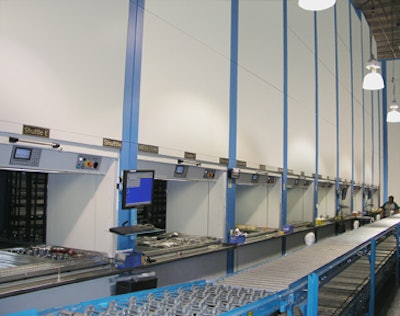
Reducing costs and achieving greater productivity within existing facilities, while improving customer service, are key to softening the impact of these uncertain economic times on storage and retrieval operations.
This can be a difficult challenge, but one that can be successfully met by initiating simple automation. Simple automation is the installation and integration of automated storage and retrieval systems, such as vertical and horizontal carousels and vertical lift modules (VLMs), into small parts and items handling operations. It's doing more with less — more efficient order picking operations at less cost and with a smaller staff — and the right combination of equipment, software and process that can significantly improve storage and retrieval efficiency.
Automated systems can be up and running over a weekend and run thousands of hours between scheduled maintenance periods. They also have the advantage of improving the efficiency and productivity of parts picking, up to 2/3 in some applications, while offering a more accurate method of maintaining inventories and reducing mispicks. In doing so, they increase operator efficiency and productivity, reduce inventory levels and improve customer service and satisfaction.
What Makes Simple Automation Work?
Conventional static storage systems like shelving and cabinets require order pickers to spend much of their time traveling aisles searching for items. Automated storage and retrieval systems allow quick access to goods by bringing items to the operator at an ergonomic height.
Automated systems also take advantage of unused overhead space. "Floor to truss" space optimization can reclaim up to 85 percent of the space used by traditional rack, shelving and drawer systems. Recovered space can often be converted for use in more value-added operations.
Automated storage and retrieval systems provide 100 percent accessible storage and are designed to deliver stored items at an ergonomically optimized height to eliminate bending, stretching and reaching. Operators scan a barcode or enter the part name or number into the system and stored items are automatically delivered to the operator, reducing labor requirements by up to 66 percent.
Easy-to-use controls and software, plus integrated pick-to-light technology, improves throughput up to 600 percent in some applications while increasing accuracy to 99.9 percent levels. Inventory management and control software can be used alone or interfaced with proprietary inventory control software to assure optimum inventory levels.
Meeting Green and Lean Initiatives
All of these benefits of simple automation add up to savings, with a return on investment (ROI) as little as 18 months, depending on the type of system installed.
In addition, implementing a program of simple automation to help reduce the impact of the current downturn in the economy can also provide a foundation for long-range sustainability and cost reduction programs.
For example, by reducing the amount of space required for storage and retrieval operations, automated systems can help companies reduce energy costs, thereby reducing their carbon footprints, through more efficient space utilization. When it's time to expand, more efficient space utilization offered by automated systems allows companies to construct smaller, more energy efficient buildings, shrinking the construction footprint by up to 15 percent in some cases, conserving natural resources and reducing long-term maintenance costs.
Conservation of human resources is critical in not only meeting performance objectives, but also in meeting sustainability goals. Since the access area of vertical systems is ergonomically designed to present stored items at an ideal height for picking — usually about waist high — unnecessary or excess motion is eliminated, reducing employee stress and injury. The elimination of excess motion normally associated with conventional rack-and-shelf systems generally improves throughput as well. More efficient operation reduces energy consumption, which helps reduce an organization's overall carbon footprint.
The reduction of wait time is a key consideration in Lean manufacturing. Static storage systems require employees to spend up to 70 percent of their time traveling aisles searching for items and only 30 percent actually retrieving items. Typically, with automated storage and retrieval systems, an employee's walk and search time is reversed from that of conventional systems to 70 percent item retrieval and only 30 percent dwell time. In some operations, productivity can increase by more than 400 percent as a result.
Redundant or non-essential handling can also be reduced with automated systems, especially in applications requiring frequent reuse of stored items. Since automated storage and retrieval systems can integrate software controls that can restrict and track part usage to specific individuals, departments or shifts. The time saved also results in less operating cost and improved operating efficiency.
Automated storage and retrieval systems can be easily configured to accommodate physical changes in stored items, allowing companies to keep on hand only what they need, effectively reducing overstocking.
Automated storage and retrieval systems can be equipped with microprocessor controls, position indicators and information displays to further increase the speed at which specific items are located and retrieved in the system. Labor costs are reduced due to the system's shortened retrieval times.
Conclusion
Companies looking to reduce the impact of the slower economy should consider simple automation as an easy way to reduce costs, improve overall storage and retrieval efficiency and make the best use of existing facilities. Simple automation also has the potential to become a solid foundation for future programs designed to meet sustainability and Lean manufacturing initiatives.









